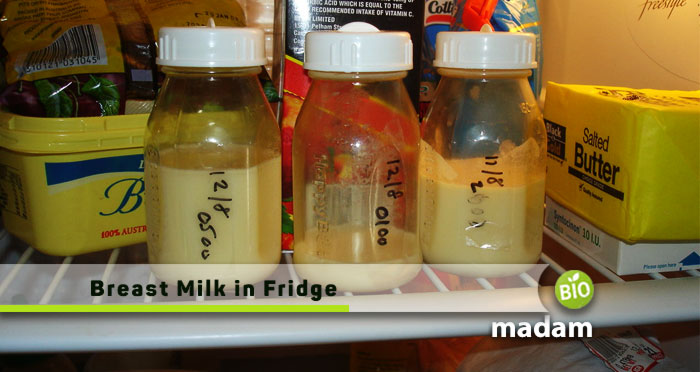New mothers have enough to think about without worrying over whether that bottle of pumped milk is still fresh. Determining exactly when it’s time to toss milk can be confusing. Guidelines vary slightly depending on the source, leaving many moms unsure if what they have stored is still safe for baby. Getting accurate information is key, as breast milk spoilage introduces risks associated with bacteria accumulation.
This article will provide clear details on just how long breast milk keeps in refrigerator conditions. Factors impacting shelf life, proper storage methods to maximize freshness, and signs milk is expiring will be covered. Moms can feel confident knowing what to look for and when pumped milk has reached the end of its safe storage duration.
How Long Can Breast Milk Stay in the Fridge?
Maintaining the freshness and nutritional integrity of breast milk relies on proper refrigeration. It’s crucial to set your refrigerator within the recommended temperature range of 32-39°F or 0-4°C to provide an optimal storage environment. Freshly expressed breast milk can be safely stored in the fridge for up to four days. Any leftover milk beyond this timeframe should be discarded to ensure the highest quality for your baby.
Regularly inspect stored breast milk for signs of spoilage, including an off smell, discoloration, or unusual texture, and promptly discard any milk showing these indicators. This attention to proper storage practices ensures that your baby receives the best possible nourishment.
Storage Guidelines for Breast Milk

Room Temperature Storage
For short-term storage (up to four hours), breast milk can be safely kept at room temperature. However, it’s essential to be mindful of the ambient temperature, as extreme conditions can impact the milk.
Refrigerator Storage
The refrigerator is a suitable option for storing breast milk for up to four days. Ensure a consistent temperature, ideally set at 32-39°F (0-4°C), to maintain the milk’s quality.
Freezer Storage
For longer storage periods, freezing is recommended. Breast milk can be stored in the freezer for up to six months, with deep freezers extending this duration to twelve months.
Factors Affecting Storage Duration
Considering the factors below are essential for ensuring the optimal storage of breast milk.
| Factors | Impact on Storage Duration |
| Temperature Fluctuations | Propels nutrient breakdown |
| Container Type & Material | Influences milk quality |
| Hygiene Practices | Maintains cleanliness; prevents contamination |
| Shelf Life | Defines storage duration limit |
| Proper Storage Methods | Maximizes freshness; preserves nutrition |
How Long Can Thawed Breast Milk Stay in the Fridge?
When thawing breast milk in the refrigerator, it is crucial to adhere to the 24-hour rule for optimal safety and quality. This means that thawed breast milk should be used within a 24-hour timeframe to ensure that its nutritional content is preserved, providing the best possible nourishment for your baby.
How Long Can Defrosted Breast Milk Stay in the Fridge?
When defrosting breast milk in fridge, know that it can healthily be left at room temperature for up to two hours. It’s important to note that this timeframe may vary if the room is particularly warm. To maximize safety and preserve the quality of the breast milk, it is advisable to return any unused portion of room temperature-exposed breast milk to the refrigerator within the two-hour window. This precautionary measure helps minimize the risk of bacterial growth and maintains the freshness of the breast milk for your baby’s consumption.

How to Store Breast Milk in the Fridge?
Choosing the best way to store breast milk in fridge requires careful consideration to maintain its freshness and nutritional value. Here’s a step-by-step guide on the best practices:
- Use Suitable Containers: Choose containers specifically designed for breast milk storage, ensuring they are clean, BPA-free, and tightly sealed to prevent contamination.
- Labeling and Dating: Establish a systematic approach by labeling each container with the date of expression. This ensures proper rotation, allowing you to use the oldest milk first.
- Avoid Overfilling Containers: To prevent spills and facilitate proper expansion during freezing, leave some space at the top of the storage containers.
- Organize Storage: Arrange stored breast milk by date in the fridge. This organization helps you easily locate and use the oldest milk before it reaches its storage limit.
- Maintain Hygiene: Wash hands thoroughly before expressing milk, and ensure that pump parts and storage containers are sanitized with hot, soapy water.
- Avoid Frequent Door Opening: Limit the frequency of opening the refrigerator door to maintain a consistent internal temperature.
- Use a Dedicated Fridge Section: Designate a specific section in the fridge for storing breast milk. This ensures a controlled environment and minimizes temperature fluctuations.
FAQs
Can you mix fresh breast milk with cold breast milk?
Yes, you can mix fresh breast milk with cold breast milk. When combining milk of different temperatures, it’s recommended to cool the freshly expressed milk in the refrigerator before mixing. This preserves consistency. Ensure proper hygiene and use clean utensils when combining different batches to maintain the quality of the breast milk.
Can I put breast milk in fridge after 4 hours?
To preserve the milk’s quality, it’s advisable to refrigerate breast milk within four hours of expression. Consider factors such as ambient temperature and hygiene practices when deciding to refrigerate within the recommended timeframe. Prompt refrigeration helps maintain the nutritional integrity of the milk.
Can you put breast milk in the fridge after warming?
After warming breast milk, cool it in the refrigerator before storage to maintain freshness. Be mindful of the temperature and duration of warming, as prolonged exposure to warmth can affect the milk’s quality. This precautionary measure ensures the safety and quality of the stored breast milk.
Can you refreeze thawed breast milk?
No, it is not recommended to refreeze thawed breast milk. Refreezing can lead to a deterioration in quality and potential nutrient loss. It’s advisable to use thawed breast milk within 24 hours of thawing. If there is any excess milk that cannot be used within this timeframe, it is better to discard it rather than refreeze to ensure the safety and quality of the milk for your baby.
How do you know if breast milk has gone bad?
To ensure your breast milk remains safe for your baby, regularly inspect it for signs of spoilage. Pay attention to any unusual smells, colors, or changes in texture. A sour or rancid odor is a clear signal of spoilage. Trust your senses; if the milk seems off, with a strange appearance or taste, it may no longer be suitable for consumption. Regular checks are crucial to maintaining the quality and safety of your breast milk, ensuring it remains a nourishing choice for your baby.
Conclusion
Knowing how to safely store breast milk empowers mothers to nourish their babies even when separated. Following refrigerator recommendations like the 4-day shelf life and 24-hour rule for thawed milk maximizes nutrition and freshness. Combining hygienic handling, suitable containers, organized fridge systems, and temperature control gives breast milk the best chance of retention. And understanding signs of spoilage ensures only high-quality milk gets consumed. Implementing these evidence-based practices around proper storage means both making and keeping each drop count towards baby’s health.

People call me Domonique Smith in Ross! I was always fond of helping people, so opted an MBBS degree to pursue my passion as my career. My major interests fall in dealing with pregnant ladies and helping them in the best of my wills for their comfort. I am further planning to choose Gynecology as my major, so wish me luck!

